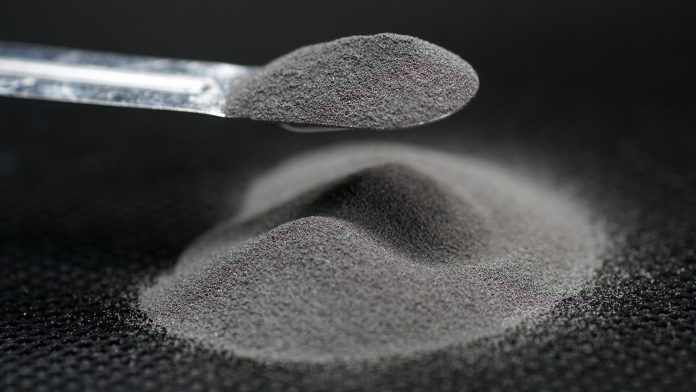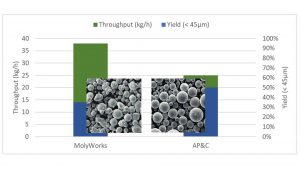MolyWorks converts metal scraps directly into powder in a single step with an inherently superior process to industry standard powder production methods.
Often, more than 55% of metal purchased for manufacturing is scrapped during part production, resulting in billions of pounds of metal scraps generated annually. The value of the scrap is often less than 1% of the purchase price and loses value proportionally to its distance from a centralised foundry. To counteract the waste of raw materials, MolyWorks is taking low value metal scrap and converting it into higher-value powders and parts. In our vision for distributed recycling, Mobile foundries will be deployed near scrapyards to produce metal powders for AM. Deployable additive manufacturing systems will be placed alongside our mobile foundries at strategic locations, using our powders to produce new parts and perform repairs.
Parts at the end of their useful life are re-melted, powdered, and printed into new parts, creating a closed-loop part life cycle. Our process can recycle nearly all of the metal waste generated by additive manufacturing (such as support structures, chips, and turnings). This circular economy has a variety of strategic and environmental benefits – lead time is minimised, feedstock cost is reduced, and numerous transportation steps are eliminated. Our distributed recycling network reduces costs associated with import duties and mitigates the need for large inventories of spare parts.
Converting scrap into powder in one single step
Traditionally, metal powder is produced in centralised foundries starting from mill products such as wire. The problem with mill products as a feedstock is that they require their own multi-step process to create, leading to high costs, low energy efficiency, and long lead times. MolyWorks offers a solution to this problem by converting scrap directly into powder in a single step with an inherently superior process that has the potential to be faster, more energy efficient, and less expensive than industry standard powder production methods. Our smart foundries incorporate industry 4.0 features, such as robotics, smart sensors, and machine learning to optimise processing parameters for each unique material. Our distributed systems periodically connect to the cloud to upload material-specific manufacturing information that can ensure correct production first time.
The global metal market is valued at $500bn (~€451bn) annually. We have produced each of the main alloy families, but our initial target market is titanium. Although titanium only represents 3% of the global metal market, it accounts for over 30% of the additive market. Additive Manufacturing represents less than 1% of the total metal market today but is growing rapidly. In a recent marketing study, customers stated that material cost and selection were some of the biggest barriers to further AM adoption. MolyWorks helps to accelerate AM adoption by providing lower cost materials and improved material selection.
Inside the foundry, a plasma heat source melts the metal alloy quickly with temperatures as high as 24,000 Kelvin. While ceramics are typically found in conventional systems, no yttria, zirconia, graphite, or tantalum are used in our process. Our ceramic-free cold hearth can be used to melt and refine a wide variety of metals including titanium alloys. The melting system can remove high density inclusions, and vaporisation of unwanted low-density elements can be accomplished with the addition of hydrogen to the plasma gas.
After melting, the metal alloy is delivered to an atomisation gas stream which captures and disintegrates the metal into fine particles. During primary atomisation, metal is spread into sheets which form bags. When these bags burst, they form smaller droplets. A similar process occurs at smaller scale in secondary atomisation to form fine particles. It all happens very quickly, which is why we need a high-speed camera to observe the mechanisms. Near the molten stream entry point, bag and bag-plume breakup modes are observed. Secondary atomisation occurs in the higher velocity region, where plume-sheet and sheet-thinning breakup modes are more dominant.
MolyWorks is currently experimenting with a variety of custom 3D-printed nozzles to create complex gas flow patterns that improve yields and reduce fouling. We are also using computational fluid dynamics modelling to increase the efficiency of our atomisation system. In one experiment, we compared two gas nozzle types. The model showed that velocity within the gas stream could be be maintained approximately 50% farther away from the nozzle by modifying the geometry of the diverging section. We are also simulating gas flow patterns within our atomisation chamber to eliminate problematic eddies and dead zones which trap powder. In one experiment, we strategically placed a baffle to disrupt a gas flow pattern that was creating wind near the molten stream. By calming the wind in the chamber, we were able to increase yield repeatability and decrease fouling on the atomisation nozzle. Moreover, in-situ particle size analysis is being used to improve our particle size selectivity in atomisation. In another experiment, we can see that the particle size of our powder went up briefly during atomisation. By understanding the dynamics of our process with respect to time, we can utilise existing data collection systems to identify process conditions which are the most favourable and eliminate unwanted deviations.
Since 2016, we have tested over 110 unique atomisation configurations, improving yields from 28% to 92%. We also improved production rates from less than 10 lb/h to a new record of 85 lb/h. Each year we have brought our average yield up to slightly higher than the previous year’s peak yield. We have produced AM-grade powder by recycling rolled homogenous armour, stainless steel armour, and battlefield scrap aluminium. We have converted scrap Inconel 718 downhole drill collars into powder, and 3D-printed that powder into a new set of flow diverters, demonstrating the entire closed-loop part life cycle. Additionally, we have produced copper powder using only turnings as feedstock. We are currently recycling a variety of titanium aircraft parts, converting that material into fresh powder and new printed parts.
Our quality control process includes a reflected polarised light microscopy technique which reveals mineral contaminants with high contrast and vibrant colour. A single mineral particle might not be large enough to show up on chemical composition tests, but it could still create a hard defect that accelerates crack formation.
Safety is our highest priority at MolyWorks. Even though we are not required to by law, we supply powered air purifying respirators to our workers, and we have developed our own custom air particulate monitoring system which provides our staff with a simple color-coded indication of air quality in our facilities.
For traceability, we use another in-house developed system called MolyWare. This database tracks our material from feedstock to powder to part. It includes chemical composition data, foundry process variables, additive manufacturing parameters, and characterisation results. In addition to storing data, we can use MolyWare to build sales orders, alloy recipes, powder lots, and automated reports.
Andrew LaTour
Chief Innovation Officer
MolyWorks Materials Corporation
+1 (510) 396-6140
alatour@molyworks.com
www.linkedin.com/company/molyworks/
www.molyworks.com
Please note, this article will also appear in the first edition of our brand new quarterly publication. Subscribe here for all the exciting news updates.








